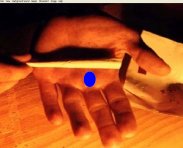EMDR THERAPY- AN INTRODUCTION
The protocols that therapists use when treating patients via EMDR ensures that this raw processing power is accesses in a controlled and measured manner. This helps to ensure predictable outcomes and tends to mean that even the most traumatic episodes are broken down into smaller chunks. In turn this helps to make the process of dealing with potentially traumatic material as painless as possible. Another way of thinking about EMDR is that when we are in the midst of an issue the creative / emotional hemisphere tends to be more active than our more logical / stepwise hemisphere. Bilateral stimulation generates activity in each hemisphere equally and probably forces more communication through the corpus callosum (the bridge between the hemispheres) which in turn may mean that we are able to access more parts of both hemispheres. The overall effect after treatment certainly seems to be that situations can be viewed more objectively and logically in situations where previously there had been emotional dominance. Whilst the precise mechanism by which EMDR helps to generate change is not fully understood it is widely accepted that EMDR is a rapid and effective treatment for a very wide variety of issues. The essential EMDR protocols can also be adapted and integrated into a variety of other therapeutic techniques.
EMDR has been used in the treatment of at least the following:
ABOUT EMDR / RYTHMIC EYE MOVEMENT THERAPY What is EMDR?EMDR stands for: · Eye Movement (eyes move from left to right / sounds / tapping) · Desensitisation (being able to recall a memory without feeling disturbance) · Reprocessing (gaining insight / seeing events in a new more productive way) o I can't accept that that happened => o It happened. I survived. I moved on. In real terms EMDR is form of exposure therapy that involves: · Bilateral eye movements / sounds / tapping · At the
same time as imagining aspects the traumatic event Claimed to be effective for the treatment of trauma / PTSD. EMDR is one a number of Eye Movement based therapies. History · Rhythmic sounds and or movements have been used for Centuries to enable people to access altered states of mind (Shamanistic traditions) · Hypnotherapists have been using metronomes and pendulums to generate relaxation for hundreds of years. REM is also an indicator of being in a trance state. o
In
the 1700's Franz Mesmer, a German born Viennese physician, for example used
rhythmic hand movements to induce altered states of mind o
In
the 1940s Harry Spitler, a medical doctor, used rhythmically flashing lights to
generate relaxation responses · 1970's various NLP techniques were developed that utilised eye movements as part of the therapeutic process itself o (Eye accessing cues / Swish Technique / Map across technique / 89+ Eye movement integration) · At some stage in the 80's Grinder taught Shapiro an NLP eye movement based trauma technique that later evolved into Eye Movement Integration (She used to work with John Grinder the co-founder of NLP) · In 1989 Francine Shapiro reported that when she thought about a troubling memory and tracked leaves blowing back and forth in the wind the intensity of the memory reduced · Shapiro labelled / re-labelled this affect as EMDR and proposed a protocol to treat trauma o The protocol provided a logical structure for therapists to follow when treating patients o Eye movement therapy has evolved over time and protocols exist covering a wide variety of issues · Rhythmic eye movement based therapies include o EMDR & Eye Movement Technique (EMT), (1st published in '89 Developed from work by John Grinder / Robert Dilts and others. Fast tracking speeds.) o EMI Eye Movement Integration therapy (Connirae/Steve Andreas ‘89 NLP Based Developed from work by John Grinder / Robert Dilts and others. Slower, gentler tracking speeds.) · EMDR and EMI were used successfully in trials with Vietnam veterans suffering from PTSD that had not responded to other forms of treatment What does it involve?· First the process is explained to the patient so they know what to expect · A safe place is defined and a stop signal is agreed o The patient or therapist may stop the process at any time · The patient is then asked to focus on the therapists fingers as the therapist moves their fingers from left to right and back again o Or the patient focuses their attention onto sounds that typically move from left to right and back again o Or they focus on shoulder or hand tapping again that moves from left to right and back again o The common factor is focusing on some form of rhythmic stimuli that typically moves from right to left and back again · At the same time the patient is asked to think about something or to focus on a particular feeling · At regular intervals the therapist asks the patient to o rank their level of disturbance
/ distress when e.g. recalling a memory on a scale (SUDS) o rank how strongly they believe in something (VOC) · Typically the level of intensity of the memory reduces rapidly as the therapy progresses · Also, the strength of limiting beliefs reduces and the strength of positive beliefs increases · EMDR therapists incorporate many other forms of psychotherapy into EMDR treatment or use EMDR in it's pure form · Many non EMDR therapists use EMDR/EMI as techniques during the course of non-EMDR therapy Theories· Hemispheric balancing o Rhythmic stimuli generate activity in the left and then the right hand sides of the brain and then back again o This is thought to balance activity between the two hemispheres § May also increase the level of communication between the hemispheres (Corpus callosum) o This may be important when the right hemisphere is dominant § the left hemisphere being responsible for logical thought § the right hemisphere being responsible for emotional thought · REM emulation / Unconscious Search o When we dream our eyes move rapidly back and forth from left to right. o The reasons for this are not clear but it has been proposed that when we dream we are: § Consolidating memories § Reinforcing neural pathways § Processing emotions and experiences · ie processing information o Some studies suggest that we are more able to make associations between things when we are in REM Mode o Rhythmic eye movements may be enabling the brain to access this high speed processing mode when awake o Alert REM may help to unblock the natural processing mechanisms if they are unable to process a particular event (eg because we awaken during a nightmare because the emotional intensity is too great) o Bursts of REM also occur when in a hypnotic trance when searching for something or processing information § This can be the result of an unconscious search process whereby when primed to resolve an issue we unconsciously seek solutions (Crossword puzzle example) · Parasympathetic nervous system activation (Relaxation response) o The sympathetic nervous system is responsible for us being awake / alert through to being stressed o The para-sympathetic nervous system is responsible for us being relaxed through to being asleep o Rhythmic movements and sounds help us to activate the para-sympathetic nervous system ie generate a relaxation response § Regardless of whether bilateral o When relaxed it is easier for us to deal with our issues and consider them more logically · Sub modality shifts (NLP concept) o An emotion can be thought of as consisting of a number of components e.g. a thought + an associated internal bodily sensation o If you reduce the internal bodily sensation (by whatever means) it allows the thought to change o Rhythmic eye movements help to reduce internal bodily sensations that are associated with trigger thoughts or images or situations § Images from memories (trauma) § Images in the real world · Phobias spider + fear sensations · Addictions substance + cravings / disgust · Reminders of past events car + fear o Beliefs can be weakened when associated thoughts and images have reduced emotional content Treatment of traumaBasis of trauma· A number of forms of trauma treatment are based on the concept that a memory has been ring-walled or isolated because the content of the memory cannot be faced. · This aspect of the self is sometimes known as a dissociated part · The part strives for attention and resolution which results in o Flashbacks, nightmares, intrusive memories o Exaggerated emotional and physical reactions to triggers that remind the person of the trauma o Avoidance of triggers o Emotional numbing o Hyper-vigilance (exaggerated startle response) / anxiety o Emotional outbursts (anger / sorrow / ...) · Bilateral stimuli helps a patient to face the overall memory by dealing with it one chunk at a time until the entire memory can be reviewed without significant disturbance o The emotional content of the memory is reduced to manageable levels chunk by chunk · Throughout the process some level of relaxation is experienced this helps greatly with the desensitisation process o In effect the patient is reconditioned to experience eg calm when recalling aspects of a memory · Trauma is generally not treated until 3 months have elapsed since the event occurred o This allows natural processing to occur (if possible) · After 3 months have elapsed more involved therapy can be provided to help the natural processing re-engage TreatmentThe most disturbing or significant image from the event is identified and scaled · Limiting beliefs that resulted from that event are identified · Equivalent positive beliefs are also identified · Beliefs are scaled to identify how much someone believes in that belief · Eye movements are generated at the same time as the person thinks about the most significant image, the limiting belief and any associated bodily sensations at the same time · After each block of about 24 sets of movement the patient is asked what came up in terms of thoughts, sensations and images · After some time the level of disturbance that the image generates is scaled · The eye movements continue until the level of disturbance is at a low level · Generally the internal bodily sensations will have reduced and the level of belief in the limiting belief will have reduced · The positive belief is then focused upon at the same time as experiencing eye movements. · This typically reinforces the positive belief. · Finally any remaining unwanted internal bodily sensations are removed by focusing on them and experiencing eye movements Treatment of addictionsBasis· An addiction can be viewed as being a strongly conditioned behavioural response to a series of internal or external triggers o Internal: Responding to stress / anxiety / cravings o External: Walking past a dealers house · Most addictions are strongly supported by an inability to deal with and manage stress / anxiety · Many people that experience additions strongly focus on and psychologically amplify the internal bodily sensations associated with the presence or absence of the substance · Addictions can be strongly supported by limiting and inaccurate beliefs e.g. that someone cannot live without the substance, this is reinforced when they experience withdrawal effects and reinforced when they attempt cessation and fail o They respond as they would to the absence of something necessary for survival e.g. water · Only a proportion of those that are addicts have a major trauma in their pasts o When a substance is removed the past issue may or may not naturally resolve itself · Loss of confidence / self-esteem can be a major issues · Physical changes to the brain may complicate matters in advanced cases · Different substances have very different withdrawal symptoms o Sedating (anxiety / insomnia / ...) o Stimulating (depression / boredom / ...) Treatment (EMDR/EMI + whatever else is required)· With addictions it is advantageous to use a variety of techniques and therapies to help ensure long-term success · Treatment is generally provided after physical dependence has been overcome i.e. post detox (where detox is required) · A decision has be made in terms of whether aim for cessation or control · Without willingness on the part of the patient therapy will probably not generate long term results (This goes beyond simple denial) · Success rates with all forms of therapy / support are low in comparison with other issues (I think the AA quote a figure of 3%) · The conditioned response of desire in association with trigger situations or images of the substance are removed o Reduce associated internal bodily sensations AND / OR o Replace the desire response with an aversive response or nothing at all · The limiting beliefs are targeted I can't => I am (they will already have been weakened) · ++ Stress / anxiety provoking situations are desensitised... · ++ Stress / anxiety management techniques are provided... · ++ Internal resources are strengthened... o Confidence o Self-esteem o Assertiveness o Control · If present past traumas are generally dealt with after the addiction has been tackled EMDR / EMI CONTRAINDICATIONS
|
|
|



